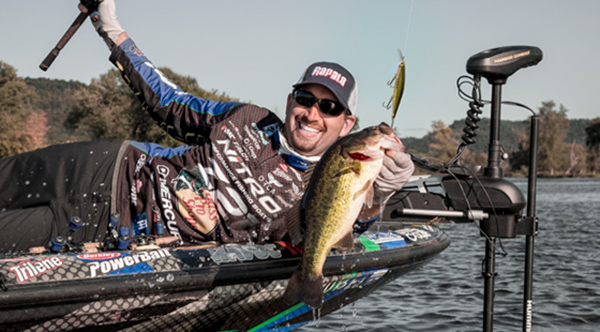Rapala Report
 Jerkbaits Catch Early-Winter Bass
Jerkbaits Catch Early-Winter Bass
When water temperatures drop below 52 degrees in Tennessee’s Douglas Lake, you can load your boat with bass by jerking Rapala Shadow Rap Deeps across and over shallow shelves near steep breaks into deeper water.
“Those fish were back in really flat stuff feeding throughout the fall, but in early winter they’ll head to stuff that’s going to be real steep,” says Ott DeFoe, a five-time Bassmaster tournament champion. “When they’re in transition, a great bait to connect with them is that Shadow Rap Deep. It’s got good side-to-side darting action, its flat sides give it a rolling flash, and as its name indicates, it’s a fairly deep-running bait – it will run 8 or 9 foot deep on 10-pound line.”
While most look-alike jerkbaits follow a forward trajectory with each twitch of the rod tip, the Shadow Rap’s action stands out. Not only does it dart side to side, it’ll spin around almost 180 degrees with the right action applied. As a result, it can trigger bites in three phases of your retrieve – initial kick, snap back to action, and on the pause, while slowly sinking, nose down.
DeFoe studies a contour map for relatively flat “shelves” extending from near the bank out to a break-line where the bottom begins sloping sharply into deeper water. Depths on the shelf can vary from 3 to 10 feet, but water on the other side of the break will be significantly deeper.
“You’ve got some taper where those fish can pull up and feed, but then it comes off from that and breaks off deep pretty quick,” explains DeFoe, a Rapala pro. “A half a cast off of the bank or so, you may only be in five feet of water. But the next half a cast, it goes from five to 20 feet pretty quick.”
In these areas, DeFoe casts his Shadow Rap Deep as far as possible, and at an angle perpendicular to – rather than parallel with – the bank and break-line.
“You’re never exactly sure what depth they’re going to be at when you pull up to a spot,” DeFoe explains. “So I make as long a cast as I can and cover every depth range back to the boat – versus making a parallel cast, where my bait would be in mostly the same depth throughout my retrieve. Most times, I’m sitting deep and throwing as shallow as I can reach.”
Be sure to actively fish your Shadow Rap Deep all the way back to the boat – not allowing your mind to wander towards the end of your retrieve – because bites this time of year can come both far and near.
As water temps cool throughout the early winter, Defoe will apply less and less action to his Shadow Rap Deep. “In 54 to 52 degrees, I’m still going to snap the bait pretty hard,” he says. “But you start getting down to 48, 46, I’m going to ease the bait along a little easier – the less I’m going to put in the jerks.”
In East Tennessee, anglers generally start testing early-winter patterns when water temps fall to 54 to 52 degrees. “From there, I consider it to be more winter than late-fall around here,” he says.
Another variable, region to region, is water clarity, which affects both the depth at which early-winter bass will hold, and the amount of action required to get bit.
“The water clarity in our lakes is not so that we’re catching them ten feet down in 20 or 30 feet of water,” DeFoe explains. “Fish that are catchable here this time of year are within no more than five feet off the bottom. We’re not a Table Rock, or a place like that, where’s there’s timber and things that the fish will relate to and be high in the water column.”
DeFoe keeps a close eye on his sonar unit, noting if the bass he marks are belly to bottom, or suspended just above the bottom. He adjusts his boat position and retrieve accordingly, to put his Shadow Rap Deep in the strike-zone.
“If they’re relating real close to the bottom, then you need to make some bottom contact with that jerkbait throughout your retrieve,” he instructs. “The Shadow Rap Deep, you can fish it five to seven feet down and get some bottom contact. But you can also get it out there in 8 to 10 feet and have it be not too far from the bottom, if that’s where the fish are holding.”
In clear to lightly stained water this time of year, DeFoe will pause his Shadow Rap Deep longer between jerks. When the water is stained to muddy, he waits less.
“The clearer it is, the longer you can let it sit,” he says. “Those fish can see it from a greater distance even when it sits still, so they’re likely to move further to come get it.”
DeFoe’s favorite color patterns this time of year are Elite Blue for clear water, Bud for stained to muddy water and Olive Green for slightly stained water.
DeFoe fishes Shadow Rap Deeps for early-winter bass on 10-pound-test line with a medium-action 6-foot, 6-inch to 6-foot, 9-inch baitcasting rod.
“This is one of the techniques I use the shortest rod for, because you’re working the bait down towards the water with the rod tip,” says DeFoe, who is about six-foot tall. “So having a shorter rod – where you’re not constantly digging in the water – is a plus.”





